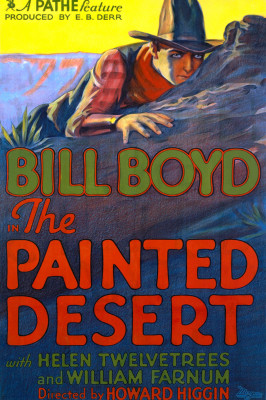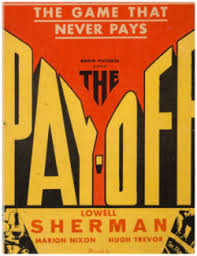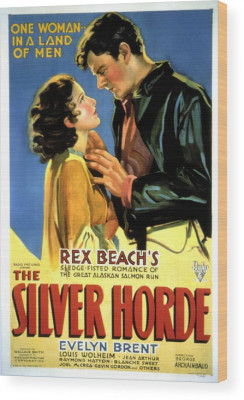| Reviews & Columns |
|
Reviews DVD TV on DVD Blu-ray 4K UHD International DVDs In Theaters Reviews by Studio Video Games Features Collector Series DVDs Easter Egg Database Interviews DVD Talk Radio Feature Articles Columns Anime Talk DVD Savant Horror DVDs The M.O.D. Squad Art House HD Talk Silent DVD
|
DVD Talk Forum |
|
|
| Resources |
|
DVD Price Search Customer Service #'s RCE Info Links |
|
Columns
|
|
|
RKO Classic Adventures (The Painted Desert / The Pay-Off / The Silver Horde)
To call these three films RKO titles is slightly misleading, as all were actually produced by Pathé around the time Joseph Kennedy's Film Booking Offices (FBO) and the theater chain Keith-Albee-Orpheum (KAO) joined the larger Radio Corporation of America (RCA) to form RKO Radio Pictures. Only The Silver Horde bears the familiar RKO logo.
Note: The back-cover text errs in touting "four newly-restored action-packed film." There are, in fact, three.
The best-known of the trio, The Painted Desert is an early talkie Western starring a pre-Hopalong Cassidy William Boyd (credited here as Bill Boyd), with silent stars William Farnum and J. Farrell MacDonald in supporting roles, while featuring Clark Gable in his first part in a talkie, and his first substantial and credited role.
The familiar story opens with two cowboys, Jeff (MacDonald) and Cash (Farnum) finding a baby alone in an abandoned covered wagon. Both are eager to raise the young boy, but Cash wins out, prompting a decades-long feud.
Now a grown man, the Bill Holbrook (Boyd) lives on his adoptive father's cattle ranch while Jeff struggles nearby, with his adult daughter, Mary Ellen (Helen Twelvetrees) and newly hired hand Rance Brett (Gable). Bill discovers tungsten on Jeff's property and strikes a deal to mine it, hoping the arrangement will bring about a reconciliation with the two old men who found him as an infant. Unfortunately, this only escalates the animosity, and while Bill falls for Mary Ellen, so too does cowboy Rance, adding to the tension.
The Painted Desert is notable for its extension location shooting and its cast. According to Wikipedia, "ninety percent of the film was shot in Arizona, between the Painted Desert in Dinosaur Canyon, and Tuba City, Arizona, as well as a nearby Indian reservation." Some exterior inserts were clearly shot back at the studio, along with most of the interiors, and one location closely resembles and might even be Red Rock Canyon, a popular shooting location about 90-minutes north of Los Angeles. But the Arizona vistas are certainly impressive, especially in an early talkie.
William Boyd had been a major star of the late silent era and adapted to talkies well, despite his thick midwestern accent. Soon after this he was embroiled in a scandal not of his making, when news reports confused him with another actor, William "Stage" Boyd, arrested on liquor and gambling charges. William Boyd was dropped by RKO, but his career recovered when he was cast in the first of 48 (!) Hopalong Cassidy movies (and later a TV series), which defined the rest of his career, so beloved was his portrayal. For Hoppy fans, The Painted Desert plays almost like a Hoppy origin story.
Farnum and MacDonald were huge stars of the silent era, and until their deaths each kept busy in films into the 1950s, albeit generally in small supporting parts. MacDonald turned up in small parts in many of Preston Sturges comedies, and is the disgruntled owner of the tree Jimmy Stewart crashes into in It's a Wonderful Life. Farnum turned up in movies as varied as The Mummy's Curse and Samson and Delilah, making one his last movies with Clark Gable, 1952's Lone Star. Similarly, Charles Sellon, who plays the old sidekick role in this, would soon be immortalized as Mr. Muckle the blind man in W.C. Fields's classic It's a Gift (1934). Helen Twelvetrees was a major star of the period, but her ingenue role here is unremarkable, and her hair and makeup anachronistic to the point of distraction.
Mostly, The Painted Desert has a B-Western plot but produced on a much larger scale. The most impressive scenes involve something this reviewer has never seen in any other Western before or since, probably because of its expense and logistical challenges: two 20-mule team train, each hauling (in the film) many tons of tungsten in two oversized wagons, like colossal semis. Such teams, actually consisting of 18 mules and two horses, were a popular means of shipping borax ore out of Death Valley and are accurately depicted here. Even for Western movie fans, they are a unique sight, really something.
Overall, however, The Painted Desert is only fair. Shot in the fall of 1930, it's still encumbered with one of the fatal flaws of most early talkies: all the actors enunciate their lines very carefully and speak v-e-r-y s-l-o-w-l-y. Although this release runs about 75 minutes, 10 minutes shorter apparently than the original release version, it's still a 60-minute plot stretched an extra quarter-hour because of the dialogue. (*** out of *****)
The Pay-Off is a Hollywood movie brimming with the kind of hoary clichés people who never watch old movies imagine all old movies contain. This crime film features a gentleman gangster with a heart of gold that abhors violence, revolves around an absurdly naïve engaged couple, and everyone calls guns "gats."
In New York, young lovers Nancy (Marian Nixon) and Tommy (William Janney) foolishly fall asleep on a park bench after midnight and are robbed at gunpoint of the $260 Tommy has saved up for their wedding. Even more foolishly, they then don white kerchiefs over their faces, intending to steal their money back from gangster Rocky (Hugh Trevor), albeit with an unloaded pistol.
This confrontation occurs at the swanky apartment of dapper gang leader Gene Fenmore (Lowell Sherman, who also directed). He uses his gentlemanly manner and high-style living to hobnob with Manhattan's elite, who in casual conversations reveal the hiding places of their valuables. Gene is unhappy with Rocky's theft, and not only returns the money to the swell kids but, taking a paternal interest, offers them employment at double their present salaries. Oblivious to Gene's occupation, they blithely accept his offer, never questioning his motives.
Rocky, however, anxious to move up the crime ladder, wants to oust his boss. He tricks Nancy and Tommy into acting as unwitting decoys at a jewelry store robbery that turns sour when Rocky shoots dead one of the clerks. The District Attorney (Alan Roscoe) suspects the kids are tied in with the crime, while Gene is determined to keep ‘em "clean."
Lowell Sherman was film and theater actor typecast as suave villains and playboys (his pencil mustache no doubt a contributing factor), which he more or less plays here. Bored, he increasingly turned to directing, initially eight features in which he also starred. Those films aren't much remembered, but after that he quit acting entirely to concentrate on directing and immediately helmed two huge hits: She Done Him Wrong with Mae West and Morning Glory (both 1933) starring Katharine Hepburn. He was directing another important picture, Becky Sharp (1935), the first three-strip Technicolor feature, when he died suddenly of double pneumonia at age 46.
Though simplistic and not believable, the picture is nonetheless charming, entertaining, and reasonably well-paced, if generally unremarkable. (****)
A reasonably diverting melodrama, The Silver Horde, based on Rex Beach's novel, revolves around rival fishing cannery operations in Alaska. Joel McCrea stars as Boyd Emerson who, having arrived far too late to reap the rewards of the gold rush (the film seems to be set in the present-day), arrives by dogsled at a small village with friend Fraser (Raymond Hatton). They meet Cherry Malottte (Evelyn Brent), monied former prostitute, who falls for Boyd and offers him and Fraser the job of traveling to Seattle to secure a $200,000 bank loan to rebuild a cannery.
In Seattle, Boyd reunites with his socialite fiancée, Mildred (Jean Arthur), but her father is pushing her to marry wealthy Fred Marsh (Gavin Gordon) who, in an incredible coincidence, is the owner of the rival cannery. Mildred's father (Purnell Platt), conspiring with Marsh, gets Boyd's loan cancelled. Cherry, arriving in Seattle herself, gets the loan reinstated by sleeping with her banker friend, Hilliard (William Davidson). Boyd, rather hopelessly naïve, assumes Mildred's influence had turned the tide.
None of this is terribly interesting, but then once the cannery operations begin in earnest, the film picks up considerable momentum. Filmed on location in Ketchikan, in southern Alaska, the film captures the building of a huge dock, and in a long, fascinating and quite disgusting sequence, follows the netting and disemboweling of live salmon, step-by-step through the pulverizing and canning process. Looking at these ancient machines slicing and dicing the large catch is rather mesmerizing, and the long montages of huge spawning salmon, in huge numbers, makes one wonder if such schools exist today in the region.
The views of relatively unspoiled Alaska are also interesting, and there's a well-staged battle at sea between rival cannery companies, their fishing boats slammed together as the fishermen duke it out.
McCrea, Brent, and Arthur were already big stars. McCrea was impossibly handsome at this point in his career, though as an actor he's still awfully rough around the edges, a performer who only got better with age, a fine and iconic figure by the early ‘40s. Jean Arthur is miscast, here playing a standard socialite ingenue, the "other woman" obviously all wrong for Boyd from the start. It's interesting to see her in such an unusual part, glammed up in revealing silk gowns and the like, far from her later unique screen persona.
Top-billed Evelyn Brent's stardom was mostly confined to the silent era, but she's the equal of McCrea and Arthur and then some, with a very strong screen presence. Somewhat ironically, her performance is more naturalistic and less theatrical than theirs. As Cherry she's very attractive but not at all sultry or vamp-like. Another major name from the silent era, Blanche Sweet, is equally appealing in her several scenes with Brent, playing a carefree former prostitute. Sadly, this was her last feature film appearance.
Also in the cast is major stage and screen actor Louis Wolheim, playing Cherry's palooka of a bodyguard-foreman, George Balt. In the Victor McLaglen-Walter Long mold, Wolheim had prominent roles in many silent films, often with John and/or Lionel Barrymore, longtime colleagues. He was cast as Walter Burns, the starring part, in the film version of The Front Page but died before that was made and his role was played, very differently, by Adolphe Menjou. One assumes Wolheim's performance would have been far closer to how that character was conceived.
An aside: the film contains what may be the most absurd supposedly romantie line (spoken by McCrea to Arthur) this reviewer has ever encountered: "How about you and I make a sirloin steak look real silly!" (***1/2)
Video & Audio
Given their age, all three titles look quite good, though The Silver Horde's opticals (fades, dissolves) are incredibly soft to the point of being out-of-focus, though straight cuts look fine. Indeed, all are impressively sharp most of the time, particularly The Painted Desert. The mono (not stereo, as the packaging states) DTS-HD Master Audio alternates between technically primitive (owing to early-talkie technology) to surprisingly clean and clear, with optional English subtitles provided. Region "A" encoded.
Extra Features
Not a thing.
Parting Thoughts
Though none of these pictures are lost classics, for fans of early Hollywood cinema, RKO Classic Adventures offers three very interesting pictures each with enough merits to warrant a look. Recommended.
Stuart Galbraith IV is the Kyoto-based film historian currently restoring a 200-year-old Japanese farmhouse.
|
| Popular Reviews |
| Sponsored Links |
|
|
| Sponsored Links |
|
|
| Release List | Reviews | Shop | Newsletter | Forum | DVD Giveaways | Blu-Ray | Advertise |
|
Copyright 2024 DVDTalk.com All Rights Reserved. Legal Info, Privacy Policy, Terms of Use,
Manage Preferences,
Your Privacy Choices | |||||||
















